How to Attract and Identify a Pine Siskin
Updated: Mar. 25, 2024
When pine siskins visit, expect a flock. These feisty finches love thistle seeds. Learn what a pine siskin looks like and hear their song.
As winter approaches, snowflakes aren’t the only things swirling around your feeders. Pine siskins sometimes fly in as they migrate from high mountains of the west and Canada’s conifer forests to America’s Lower 48 looking for food. Here’s how to identify and attract a pine siskin.
Wondering if you’ll see lots of pine siskins in your yard this year? Check out the updated winter finch forecast.
What Does a Pine Siskin Look Like?
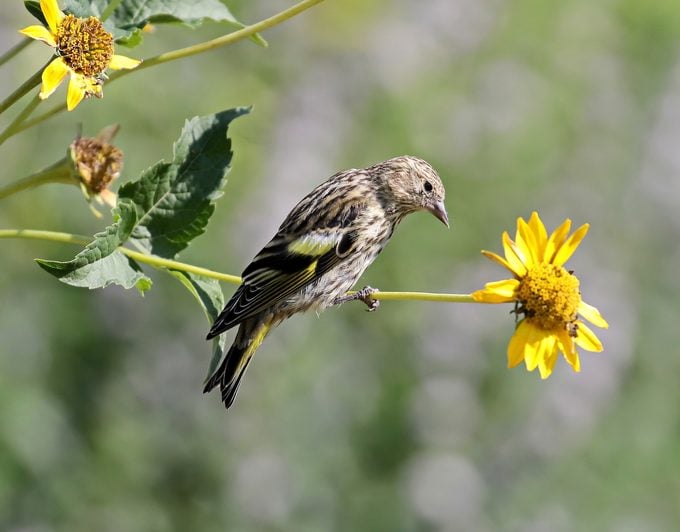
Looking similar to a sparrow but in the finch family, pine siskins have small, slender bodies that are streaky brown all over, and especially on the chest. Bright yellow markings edge their wing tips and tails, distinguishing them from house finches. Look for flashes of yellow as a pine siskin flutters from branch to branch, sometimes hanging upside down, picking seeds from pine cones or descending upon a field of thistle or wild sunflower.
Pine siskins’ pointed bills are thinner than those of other common finches. Long wings extend toward the tips of their tails. Their notched tails are easy to see in flight. These birds are 5 inches long with a wingspan of 9 inches.
Adaptable to survive cold weather and full of acrobatic antics in flight and while feeding, they are special songbirds that many birders hope to see.
Pine siskin vs goldfinch: Here’s how to tell the difference.
Pine Siskin Song
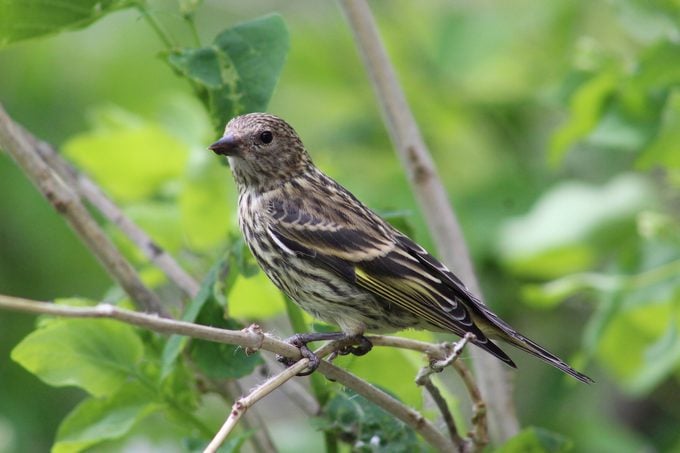
These social birds travel in large, noisy flocks that are difficult to miss. Though a single pine siskin sometimes appears in flocks of goldfinches, their close relatives. You’ll probably hear their raspy, wheezy twitters before you even see them. Canary-like calls range from a tuneful “sweeet” to a harsh rising “zzzzz” sound.
Bird songs provided by the Cornell Lab of Ornithology.
Meet the 3 types of goldfinches in the United States.
Nest and Eggs
The female pine siskin builds a shallow nest of twigs and grasses, lined with fur or feathers and lays three to five pale green-blue eggs inside.
What Do Pine Siskins Eat?
Look for these social birds flitting around thistle feeders in busy flocks. To get up close and personal with these winter visitors, simply set out their favorite food, and these opportunistic eaters will find you–and fast!
Like nearly all finches, a pine siskin’s diet consists mostly of seed, though they also eat insects such as caterpillars and aphids. In the wild, pine, spruce, alder, birch, grass, sunflower and weed seeds are their go-to foods. But in the backyard, fresh Nyjer seed (also called thistle) is a safe bet, as are black-oil sunflower seeds, millet and sunflower chips. Just be sure to have plenty on hand to keep them coming back. Pine siskins also occasionally eat suet, especially insect-based kinds.
Don’t miss super pretty pictures of finches.
The Best Feeders for Pine Siskin Birds
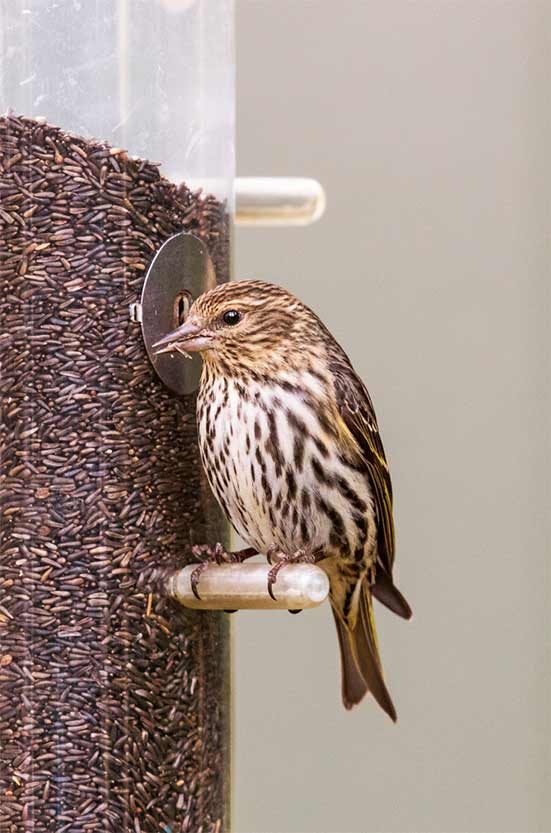
Because siskins are likely to feed by the dozens, long tube feeders that offer several perches allow for many to feast at once. And it’s best to set out multiple finch feeders because pine siskins are a feisty and sometimes combative sort when it comes to food. You also may find success by spreading seed on the ground.
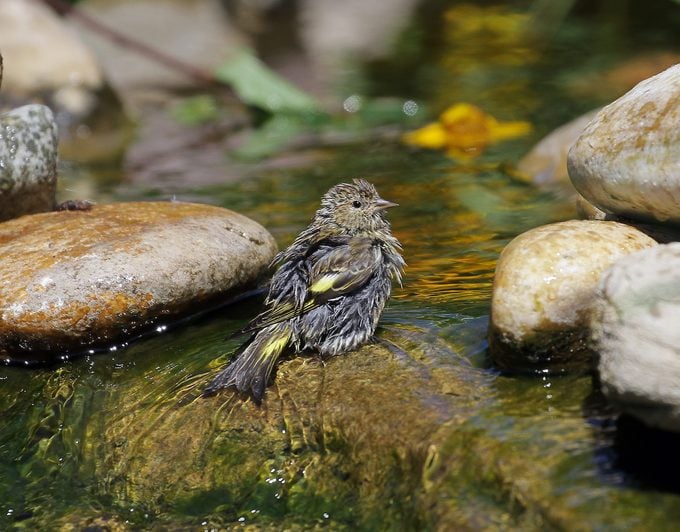
Pine siskins also love to bathe in bunches. Here’s how to keep your bird bath thawed in winter:
- Invest in a birdbath heater or de-icer.
- Put water in a heated dog dish.
- Add a small fountain to keep the water moving.
- Pour hot water over icy birdbaths in the morning to loosen ice, then fill with warm water.
Pine Siskin Salmonella
Unfortunately, pine siskins are susceptible to salmonella, which is easily transmitted from one bird to another as they travel and eat in tight groups. This happens in the wild, however, as much as it does at backyard feeders. Keep bird feeders clean to help prevent or slow the spread of the disease.
Learn more about common wild bird diseases.
Pine Siskin Range Map and Habitat
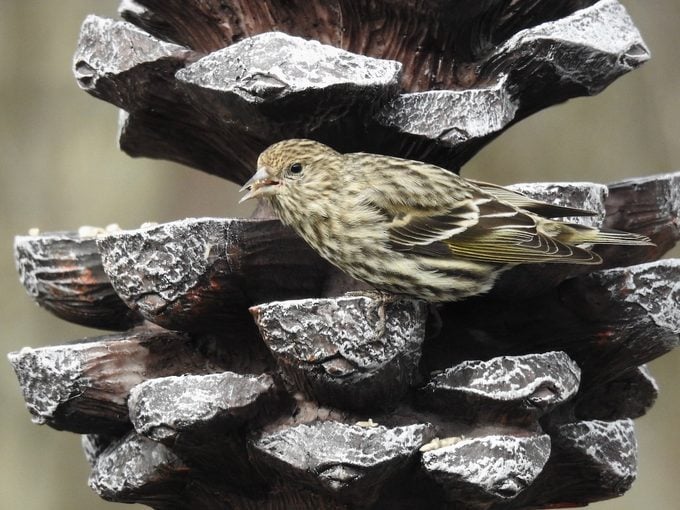
Although pine siskins call part of the west home year-round, these birds are winter visitors in most of the U.S., flying in after breeding season. They are often spotted in backyards and coniferous forests.
But their journey southward isn’t a sure thing. It’s common for birders to see pine siskins in droves one year, then nothing the next. These sporadic and geographically erratic visits are most likely prompted by a cyclical shortage of conifer seeds.
“This past winter; I was thrilled to have a large (over 150) flock of pine siskins stay by my feeders daily. Their favorite was this pine cone feeder (above). I added shelled sunflower seeds, which seemed to keep them coming. I hope they return next winter!” says Birds & Blooms contributor Nancy Tully.
Mimic their habitat to attract pine siskins. Place feeders near twiggy trees, large conifers and other dense winter vegetation so the birds have a place to go for winter shelter against the predators, snow, wind and sleet that often come with the season. Along a tree line or woody area is ideal.
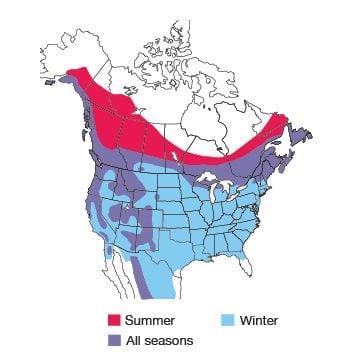
Next learn how to identify common redpolls, a cheery, hardy winter bird.
Range maps provided by Kaufman Field Guides, the official field guide of Birds & Blooms.




















